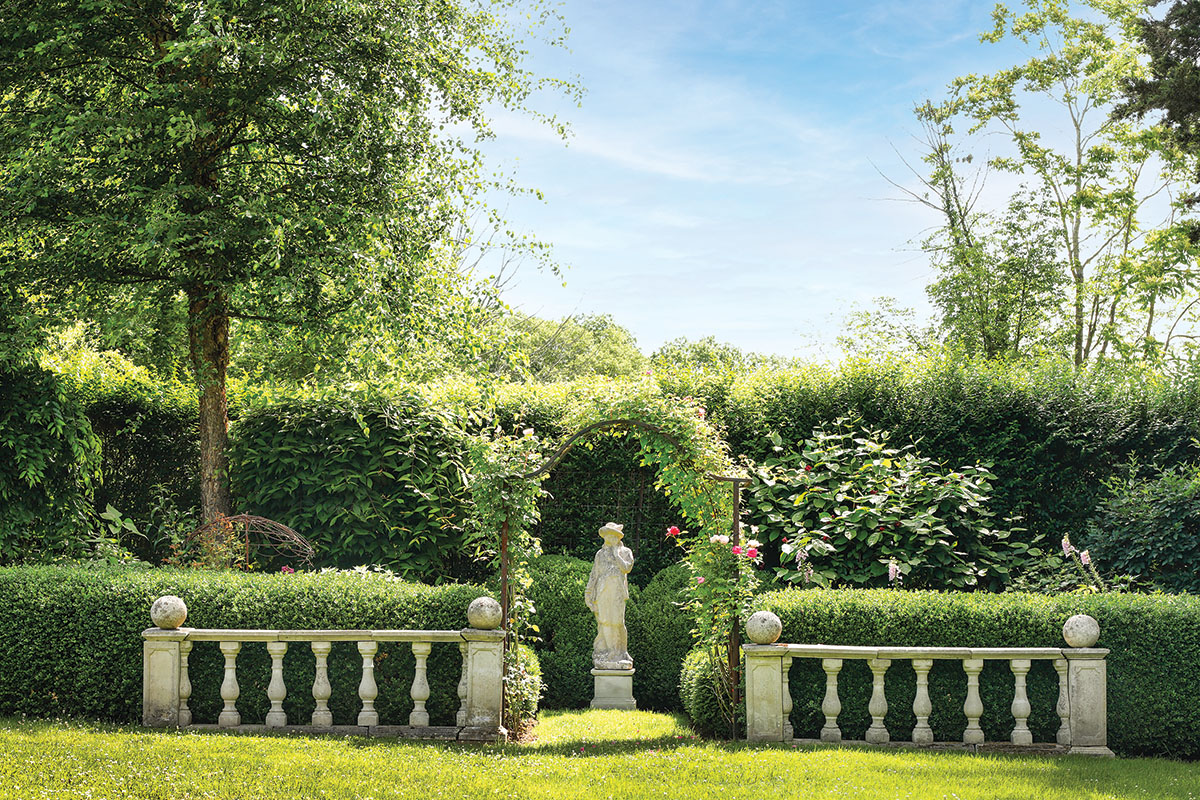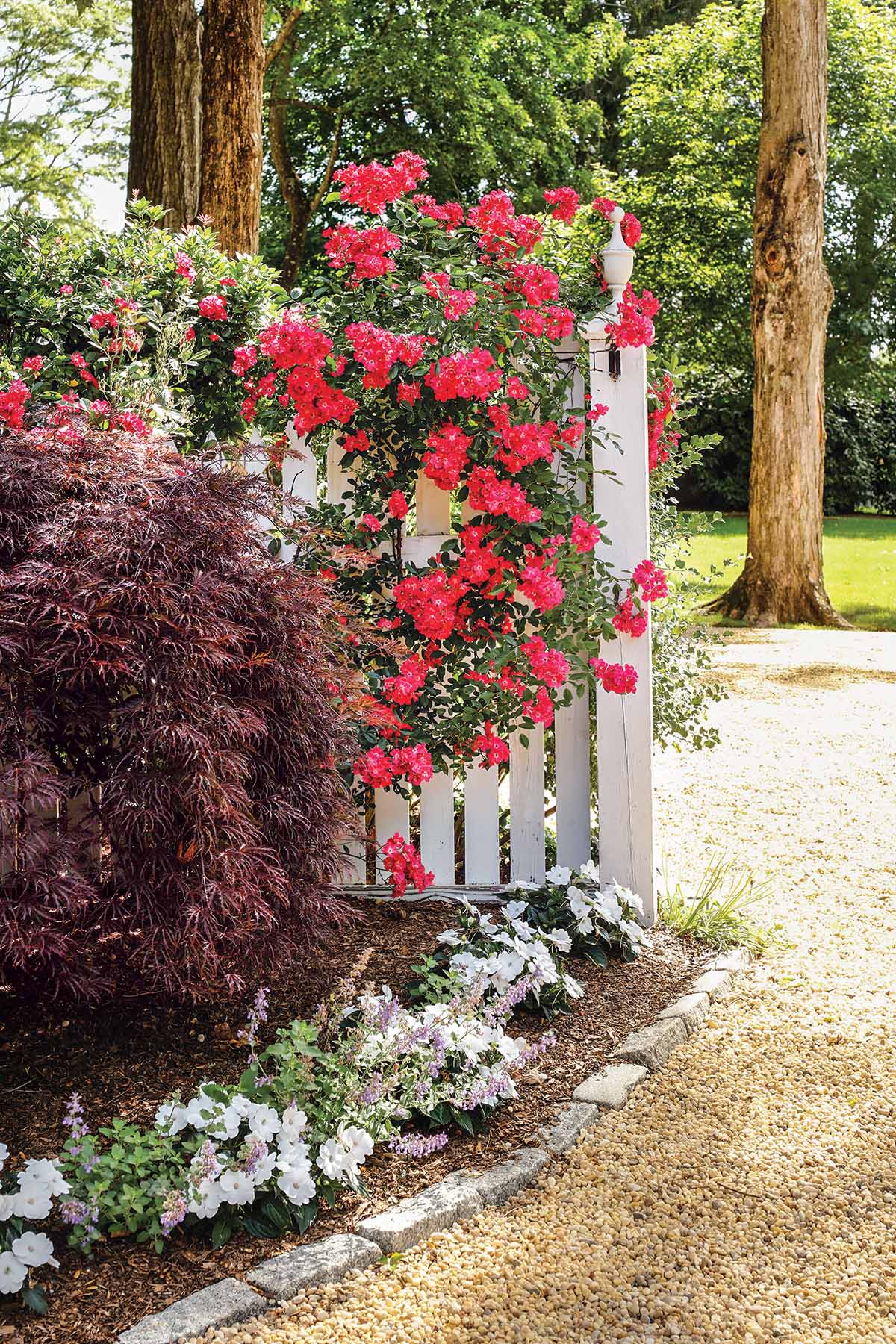
Photo © Visko Hatfield
Supporting a native honeysuckle cultivar, the arch at the end of a perennial border accents nearby Brunnera ‘Jack Frost’ and Nepeta x faassenii.
Barbara Israel always knew she would have a garden—and she knew that her garden would be formal in style. Her love of all things classical was forged at a young age when she spent summers climbing the walls of a nearby estate to gain a glimpse of its gardens. She found an instant affinity for the symmetry of the plantings. But even then, it was the statuary that really spoke to her.

Photo © Visko Hatfield
A mystery Austin rose blooms with beauty and fragrance.

Photo © Visko Hatfield
A carved sandstone statue (one of a pair of parapet figures) holds a book of music.
Fast forward to when Barbara was a young mother and, together with husband Tom, decided to buy a country house just outside of New York City. Tom had only one request: He wanted to live on a quiet road. Barbara’s must-have list was much longer, but when she toured Steepway Farm in Westchester County, she found it immediately ticked all the boxes.
Dating back to 1830, the property had a modest farmhouse on five acres. But most importantly, it had the vestiges of a formal garden, reputedly based on a hastily scribbled Frederick Law Olmsted plan. The couple snapped up the property in 1980 and then dug in—literally. Most of the plant selections and plantings were done personally. While Tom focused on populating the vegetable garden, Barbara went to work on the perennial beds. “We promised each other that we’d make ourselves stop gardening and drag our tired bodies inside every evening at 8pm for dinner,” Barbara says.

Photo © Visko Hatfield
In the pump house garden dominated by a pensive gentleman of composition stone (circa 1920), a balustrade (also 1920) offsets the hedge.
The landscape had lineage which Barbara traced to Alice Draper, in residence from 1920-1956. Draper knew and cared about gardens with such depth that she buttonholed the Olmsted firm to do the design. When the Israels came onto the scene many years later, the bones of a pair of dual borders remained intact, but the plant palette had been replaced to reflect what was readily and locally available. Barbara sought out a more curated roster of perennials, including dozens of heirloom roses. Simultaneously, she strengthened the overall layout of the land. When she asked a British friend to help with her allées, he suggested expanding an axis and then finding a meaningful piece of statuary or urn to place as a culminating focal point. But there was one transformational bit of his wisdom that proved pivotal for Barbara—he recommended pruning the surrounding trees to let light shine on the artwork. That friend had no idea how far Barbara would take his suggestion.

Photo © Visko Hatfield
For the entrance to the property’s restoration studio where artisans work on garden ornaments, fellow gardener (and author) Page Dickey suggested the bright red, repeat-blooming, ultra-fragrant ‘Robin Hood’ hybrid musk rose to wrap around the picket fence. Unfazed by the weather, the roses produce abundant blossoms that highlight a Japanese maple. Nepeta and New Guinea impatiens run around the ankles of the tree.

Photo © Visko Hatfield
Intricately carved with stylized birds, animals, and leaves, a Byzantine-style marble tazza is displayed in Barbara’s garden.
Barbara understood right away that her landscape was nothing without a garden ornament, and she set out to find something that deserved to be spotlighted. She began her search for a suitable garden statue at a Long Island estate. As Barbara explains, “I went to the property and ended up buying not just one statue but every statue they were selling—all 40 of them!” Not only did she find that truly important piece of art for her garden—which remains there today—but suddenly, she was in business.
Ask Barbara if she had any regrets, or even a slight wave of cold feet, after the extemporaneous purchase, and she adamantly denies it. “Plus, I have an understanding husband,” she laughs. Apparently, all that wall climbing from childhood paid off because Barbara quickly recognized that her 40-statue haul was filled with important works that were sold to her for a song. In fact, the quartet of Chinese musicians she bought that day were ultimately snapped up by Yoko Ono on a visit to Barbara’s shop (Barbara Israel Garden Antiques). She later saw another of her statues proudly profiled in the window of the legendary Madison Avenue antiques shop, Florian Papp. More of her treasures have since found equally prestigious homes.

Photo © Visko Hatfield
The winged cherub is a popular motif for garden ornaments. Here, the intricate bronze fountain figure (Continental, circa 1990) holds a fish while standing on a rockwork base in a circular stone basin. He serves as the focal point in a boxwood-edged parterre garden backed by a Concord grape arbor.
Barbara has been collecting garden ornaments ever since that fortuitous purchase at the estate sale, and most of her acquisitions hold temporary residency at Steepway Farm. She tries not to become too attached since everything, apart from that first statue and some inherited family pieces, is for sale. Caesar and Cupid hold court, along with Diana, Mercury, and an assortment of others, all surrounded by collections of urns and sundials. But Barbara’s favorite sculptures are the animals—from dogs and rabbits to deer, eagles, and lions.
To best display her acquisitions, Barbara has created niches that house her collection. “You have to provide the fantasy,” she says of her carefully, but temporarily, positioned pieces. And while the statuary is transient, the property does host some permanent residents, including an impressive display of unusual perennials thoughtfully placed among the garden ornaments. Steepway Farm also includes an orchard, a grape arbor, and a pump house garden. In addition, Tom’s vegetable garden has been transformed into a rose garden.

Photo © Visko Hatfield
Roses arch over the fence accented by nepeta and boxwood orbs.
While Barbara insists, “I’m not a garden designer,” the fruits of her labor tell a different story. Her deft eye has created the perfect balance between botanical and sculptural at Steepway Farm, her garden masterpiece.
Don’t miss Barbara Israel’s tips for choosing garden statuary.




